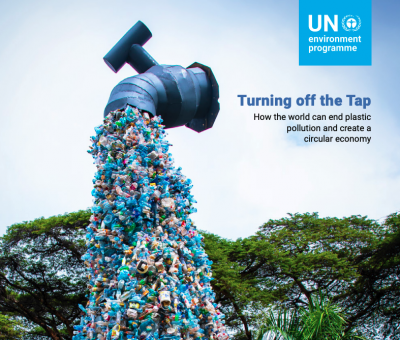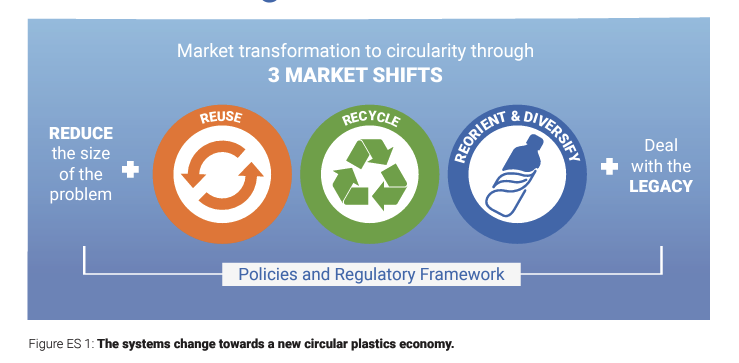

18/09/2023
Following the decision by all 193 UN Member States at the United Nations Environment Assembly in March 2022 to end plastic pollution, the UN Environment Program (UNEP) has released a report examining the economic and business models needed to address the impacts of the plastics economy.

The report states that while negotiations are now underway on a binding legal framework to come into effect in 2024, the economic, fiscal and business models needed to address the associated impacts of plastic pollution, while also safeguarding livelihoods of those involved in plastic manufacturing, are still unclear.
According to the United Nations Industrial Development Organization, global plastic production and use has grown exponentially since the 1950s, with around nine million people employed globally in polymer production and plastic processing industries. Currently, the world produces 430 million metric tons of plastics each year, of which over two-thirds are short-lived products which soon become waste, a growing amount after one single use – 139 million metric tons in 2021 according to the Minderoo Foundation. Plastic production is set to triple by 2060 if ‘business-as-usual’ continues.
Research also shows that under a business-as-usual scenario, plastic could emit 19 percent of global greenhouse gas (GHG) emissions allowed under a 1.5°C scenario by 2040, essentially making the goal out of reach.
“Turning off the Tap: How the world can end plastic pollution and create a circular economy” proposes a systems change to address the causes of plastic pollution, combining the reduction of problematic and unnecessary plastic use with a market transformation towards circularity in plastics. The report says this can be achieved by accelerating three key shifts - reuse, recycle, and reorient and diversify - and actions to deal with the legacy of plastic pollution.
Shift One: Reuse
Studies show that reuse systems provide the highest opportunity to reduce plastic pollution (a reduction of 30 percent by 2040) by replacing some of the most problematic and unnecessary products. Unnecessary plastics are those with low or no utility (over-packaging) that can be eliminated while providing the same utility, those designed for a short use period when reuse or new delivery models could provide the same utility, and those that can be substituted for alternative materials with a more sustainable footprint (as validated by Life Cycle Assessment studies).
The report calls for an acceleration towards the market for reusable products and to transform the throwaway economy to a reuse society by enabling the reuse market to have a stronger business case than the single-use plastics market.

Image credit: UNEP
Reuse schemes (also referred to as reuse systems or models), refer broadly to new delivery models in which a single product (a package) achieves multiple trips, rotations or uses for the same purpose for which it was originally used. This can range from simple bulk dispensers in-store to more complex schemes with deposits and packaging take-back, washing and repair. It includes the shift to reusable water bottles, food containers and bags, new delivery models such as refill from dispensers and bulk systems in retail, low-packaging subscription services, concentrated product capsules, and take-back services with reverse vending machines, deposit refund schemes and washing pooling systems.
Shift Two: Recycle
In 2020, a study by the Pew Charitable Trusts and Systemiq showed that accelerating the market for plastics recycling by ensuring recycling becomes a more stable and profitable venture could reduce the amount of plastic pollution by an additional 20 percent by 2040. The report calls for an adequate availability of feedstock that can be recycled and to ensure that recycled materials can compete on a level playing field with virgin materials.
Recycling can be accelerated by improving its economics, aligning the incentives in design with the recycling economy and ensuring safe and fair recycling in practice and at scale (enabling investment in infrastructure). As with reuse, the presence of specific chemicals of concern in plastics reduces their potential for circularity, and thus makes recycling less economically favorable.
Shift Three: Reorient and Diversify
Sustainable alternatives could reduce pollution by 17 percent by 2040 but struggle to compete in markets with products made of virgin fossil fuel-based polymers owing to several challenges: cost of product, consumer demand and lack of appropriate regulations.
UNEP suggests shaping the market for plastic alternatives – such as paper and compostable materials - to enable sustainable substitutions, thus avoiding replacing plastic products with alternatives that displace rather than reduce impacts.
For example, substituting with more sustainable alternative materials has higher production costs on average (one and a half to two times the cost of plastics), but in some cases substitutes can improve sustainability (sustainably sourced, recyclable paper). A virgin plastic tax would contribute to improving the economics of alternative materials by increasing the price of plastic products made from virgin plastics.
The report notes that the substitutions need to be made in an environmentally and socially sound manner, considering unintended consequences of substitutes or prioritizing substitutes that are themselves recycled materials: recycled (secondary) plastic can also be used as a suitable substitute material.
A new plastics economy
The report acknowledges that even with the market transformation approach, a significant volume of plastics cannot be made circular in the next 10 to 20 years and will require disposal solutions to prevent pollution, new ways of financing the collection and disposal of legacy plastics and preventing microplastics from entering the economy and the environment.
UNEP says that a transformed plastics economy will introduce new economic benefits by bringing new business opportunities particularly for those who adapt faster.
If a new plastics economy was implemented, the report says that by 2040 it could: (1) Create opportunities for jobs, income and innovation: 700,000 additional jobs; improved livelihoods for millions of workers in informal settings; close to USD 1.3 trillion (10.3 percent) savings in direct public and private costs between 2021 and 2040; (2) Reduce damage to human health and the environment by reducing exposure through an 80 per cent reduction of plastic pollution; 0.5 Gt CO2-eq GHG emissions prevented annually; avoiding USD 3.3 trillion of environmental and social costs between 2021 and 2040 (32.5 percent cost savings); (3) Reduce liabilities, risks and litigation associated with damage from plastics pollution; (4) When the direct, environmental and social cost savings are added up, more than USD 4.5 trillion are saved, or 20.3 percent reduction in costs overall.
Due to the cross-border flows of plastic, liabilities and risks, a new plastics economy would require harmonized international action. The report recognizes however that countries will start from different places to implement market transformations and the specific policy mix appropriate to a particular country will need to consider the trade-offs built into policy choices and options. If the amount of materials that are reused or recycled in the economy increases to 27 percent, the outflow of mismanaged plastic waste ending in the environment decreases by over 80 percent. The report states that ‘turning off the tap’ of plastic pollution is “within reach”.
Hồng Nhung (Source: UNEP)
(Source: The article was published on the Environment Magazine by English No. II/2023)